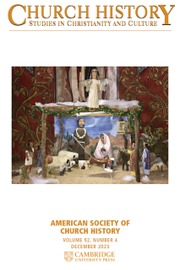Article contents
The Development of the Canon Law Since 1500 A. D.
Published online by Cambridge University Press: 28 July 2009
Extract
The body of law dealing with discipline, polity, and sacramental administration which has grown up in the history of the church is ordinarily styled Canon Law (jus canonicum), because it is a collection of canons. Canon (derived from the Greek kanon) means a rule, in a material and moral sense. Its original meaning was a straight rod. In apostolic times it signified the truth of Christianity as an authoritative standard of life and a statement of doctrine in general. It is, therefore, easy to understand how the word kanon later came to mean the ecclesiastical legislation which governed the conduct of the faithful. The excellent definition given by Archbishop Cicognani. states that “The Canon Law may be denned as ‘the body of laws made by the lawful ecclesiastical authority for the government of the Church’.”
- Type
- Research Article
- Information
- Copyright
- Copyright © American Society of Church History 1940
References
1 Galatians VI, 16; Philippians III, 16.
2 Cicognani, Amleto Giovanni, The Canon Law (Philadelphia, 1934), 43, 26.Google Scholar
3 Cicognani, , The Canon Law, 45Google Scholar, 26.4.
4 “The earliest Council whose acts we possess in formal shape.” Quoted from Ward, P. G.'s paper in Report, Standing Orders of the Church of England (London, 1934), 10Google Scholar.
5 Constitutions, Othobon, A.D. 1268Google Scholar, Introduction: “The decrees divinely promulgated by the mouths of the fathers containing rules of justice and maxims of equity have diffused themselves like rivers far and near. And the sacred constitutions of the chief pontiffs and of the legates of the Apostolic See and of other prelates of the church dispersed throughout the world issue like smaller streamlets from these broad rivers according to the diversity of times, which necessarily require new remedies for such new diseases as are bred of human frailty.”
6 Anselm of Lucca died in 1086.
7 Reichel, Oswald J., The Canon Law of Chureh Institutions (London, 1922), I, 102–103, 29Google Scholar; Cicognani, , The Canon Law, 273–288Google Scholar. Archbishop Cicognani does not accept the date 1144 as final. He leaves it an open matter between 1139 and 1151.
8 Reichel, , The Canon Law of Church Institutions, 104, 2.Google Scholar
9 Cicognani, , The Canon Law, 298.Google Scholar
10 Ibid., 309, B.
11 Ibid., 314, A.
12 Canones et Decreta Concilii Tridentini (Rome, 1845).Google Scholar
13 Cicognani, , The Canon Law, 363.Google Scholar
14 Waterworth, J., tran., The Decrees of the Council of Trent (London), 288.Google Scholar
15 Catholic Encyclopedia, XIII, 141, b.Google Scholar
16 Codex Juris Canonici (New York, 1918), p. LXV.Google Scholar
17 Catholic Encyclopedia, VII, 721, d.
18 IV Session of the Council (1546); revision was carried out in 1590–1592.
19 Catholic Encyclopedia, XIII, 142, bGoogle Scholar; also special article under “Propaganda.”
20 Gasparri, Peter Cardinal, “Prefatio ad novum Codicem juris canonici,” Codex luris Canonici, p. xix ff.Google Scholar
21 Cicognani, , The Canon Law, 421.Google Scholar
22 Ibid., 425.
23 Book II, tit. VII, ch. II, c. 222.
24 Woywood, Stanislaus, The New Canon Law (New York, 1918), 36–37, 149.Google Scholar
25 Blunt, J. H., Church Law (London, 1921), 20.Google Scholar
26 Ibid., 12.
27 Ibid., 13.
28 Bullard, J. V. and Bell, H. Chalmer, eds., Lyndwood's Provinciale (London, 1929) xxix.Google Scholar
29 Lyndwood, xxi.Google Scholar
30 Blunt, , Church Law, 14–17.Google Scholar
33 Ogle, Arthur, The Canon Law in Medieval England (London, 1912), 179.Google Scholar
32 Lyndwood, xxxii.Google Scholar
33 Ogle, , The Canon Law, 185–186.Google Scholar
34 Wooley, Reginald Maxwell, ed. and tr., York Provinciale (London, 1931), x.Google Scholar
35 Lyndwood, xxxvii.Google Scholar
36 The truth as to the status of the Corpus would appear to rest somewhere between the positions taken by Bishop Stubbs and F. W. Maitland in their well-known controversy on the subject. The views of the former are set forth in Stubbs, William, Seventeen Lectures on Medieval and Modern History (Oxford, 1887)Google Scholar, while those of the latter are to be found in Maitland, F. W., The Roman Canon Law in the Church of England (London, 1898)Google Scholar. “Both authorities would seem to have overstated their case, and perhaps the actual truth lies somewhere between the two positions.” (Wooley, R. M., preface to the York Provinciale, 7.)Google Scholar
37 Lyndwood, xxxviii.Google Scholar
38 Lyndwood, xxxix.Google Scholar
39 Blunt, , Church Law, 22.Google Scholar
40 Ibid., 22.
41 Blunt, , Church Law, 23.Google Scholar
42 Blunt, J. H., The Reformation of the Church of England (London, 1882), II, 112.Google Scholar
43 Lyndwood, xxxix.Google Scholar
44 Blunt, , The Reformation, II, 113.Google Scholar
45 Ibid., II, 113.
46 Ibid., II, 113.
47 Ibid., II, 114.
48 Bullard, J. V., ed., Standing Orders of the Church of England (London, 1934), 7, 8.Google Scholar
49 Prothero, G. W., Select Statutes and Other Constitutional Documents (Oxford, 1913), 184.Google Scholar
50 Blunt, , The Reformation, II, 370.Google Scholar
51 Ibid., II, 370.
52 Ibid., II, 371.
53 Ibid., II, 371.
54 Ibid., II, 371.
55 Ibid., II, 372.
56 Prothero, , Select Statutes, 417–419.Google Scholar
57 Blunt, , The Reformation, II, 372Google Scholar; Walcott, Mackenzie E. C., Canons of the Church of England (London, 1874).Google Scholar
58 Waleott, , Canons of the Church of England, 179–180.Google Scholar
59 Blunt, , The Reformation, II, 373.Google Scholar
60 Reichel, , Canon Law of Church Institutions, 152–153.Google Scholar
61 Ibid., 154.
62 Ibid., 155.
63 Ibid., 156.
64 Blunt, , Church Law, 24.Google Scholar
65 Reichel, , Canon Lam, I, 157.Google Scholar
66 Standing Orders, vi.Google Scholar
67 White, Edwin A., American Church Law (New York), 67.Google Scholar
68 Ibid., 81–82.
69 Hoffman, Murray, Treatise on the Law of the Church (New York, 1850), 42.Google Scholar
- 1
- Cited by


